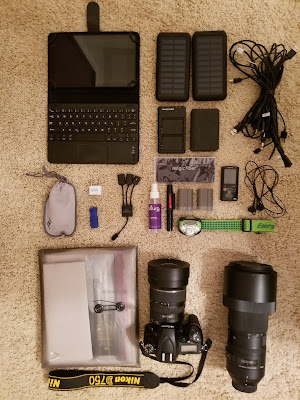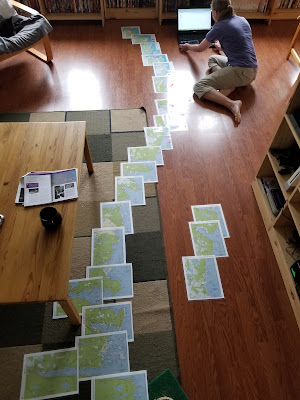East Coast Trail Hiking Gear List
East Coast Trail Hiking Gear List
Essential Supplies for the ECT
As we prepare to set out on the first section and most eastern section of the Trans Canada Trail / Great Trail, Newfoundland's amazing East Coast Trail, we have had to make several gear decisions. We thought we would share what we have chosen and our reasoning!
Tents and Sleeping Bags
Having not been required to carry a tent,
tarp or sleeping pads while on the Camino Frances in Spain, the GR trails in
France, or our End-to-End hikes along the Bruce Trail in Ontario
Canada we had fallen out of practice of adding these items to our
packs. When we began looking at the ECT and TCT it quickly became
clear that our 4 person tent which we had used for years driving to
Ontario's Provincial Parks was far too heavy an item to backpack
with. Indeed, having personally carried this 12 lb tent over 200 km
throughout a previous trip I never wanted to put it in my pack again.
In February of 2018, we splurged and
decided to go with the highly rated MSR Hubba Hubba NX (2-person),
which we then took hiking with us in Ontario on several occasions.
While this tent is certainly lightweight, durable, easy to set up
and a great size to pack in our backpacks it also provided very
little room at night for two people and required that our packs and
all of our gear were left outside. Therefore with only two weeks to
go before flying to Newfoundland, we returned to MEC and purchased
yet another tent, opting to go for MSR's Mutha Hubba (a 3-person
variation of the NX). Days after purchasing it we took it on a thru
hike on the Bruce Trail for the weekend and decided that while a
little heavier and bulkier than its younger counterpart, the Mutha
Hubba was perfect for two people on a long-distance hike. In
addition to our tent, we also packed our Aquaquest Tarp, complete with
paracord, and MSR groundsheet.
As mentioned, the potential for late-season snowfall and unpredictable weather on the East Coast led us
to turn to Facebook groups for advice on the type of sleeping bag to
bring – summer or winter. Overwhelmingly the suggestion was for us
to bring winter sleeping bags and so rather than our compact and
lightweight 3 season gear we ended up packing our bulky but
substantially warmer Marmot Never Summer sleeping bags. In addition
to we packed R4-rated military Thermarests to give us slightly
more comfort after each day's hike and protection from the cold
ground.
** Post Hike
Note – A HUGE thank you to everyone who suggested we take our
Winter Sleeping Bags and thin-down jackets. Evenings in June and
even at times in July along the Eastern Coast dipped to zero and
sometimes below. Our summer sleeping bags would have been highly
impractical for this hike during this time of the year. **
Backpacks
For our backpacks, I would be using my
near Osprey Xena 85 Woman's pack and Sean would continue to use his
trusted Gregory Whitney 95. In addition, we both will have several OR
and Osprey Drysacks to keep down food smells to avoid attracting
animals, and keep our clothes and electronics dry.
Hiking Stove
Beyond shelter, sleeping bags, and
packs, one of our harder choices for both the East Coast Trail and
Trans Canada Trail was which stove system to rely on. For years we
had used and loved our MSR Whisper Light, but the need to locate,
carry, and dispose of countless fuel canisters made this option
unattractive. Especially in remote locations across Newfoundland and
Canada. We initially thought of relying on Campfire pits along the
way which would eliminate the need for a physical stove and carrying
fuel. However many regions like Newfoundland and Alberta have
ongoing fire bans. In addition, creating pits often significantly
disrupts the natural area and are difficult to construct and use
while stealth camping. After investigating what other hikers on
the Appalachian Trail, Pacific Crest Trail, and American Discovery
Trail do to overcome this difficulty we were left with several viable
options. First taking an alcohol stove, second choosing a hobo
stove, or third not taking a stove at all and eating only cold food.
Given that I love my morning coffee and the occasional treat of warm
food on a cold night we settled on investigating designed alcohol and
hobo stoves.
Our first choice was the noted and
durable, Bushbox XL Combination Kit which eliminated the need to
carry fuel canisters and dispose of them. We used this stove for
three weeks at home and on two camping trips. It is great! It is
compact, easy to use, and durable as all heck. It also comes with an
incredibly thick black sleeve to prevent soot from getting into your
back and over everything. However as we packed our bags and they
neared 30lbs each without food, we began seeing the need to cut
weight. As such The Bushbox XL at 1.5 lbs became an early victim
owing only to its weight. Even though it was set aside for our hike
on the East Coast Trail it is entirely possible that we will return
to it as its foldable compact design makes it a huge space saver in
the backpack.
Our second choice is a stove whose
principles are clearly based on the Bushbox, the Ohuhu Portable Stainless Steel Wood Burning Camping Stove. This stove is ¾
of a pound, collapses into a small stuff sack, and costs just $20.00.
It is however where nearly as compact as the Bushbox and clearly
not as durable. We used it for two nights before heading out to
Newfoundland and on weight alone it is what we are taking. Still
uncertain of it we also added a Trangia spirit burner
to put fondue fuel into to cook our meals if the Ohuhu did not hold
up. This means that despite trying to avoid carrying fuel we will
nonetheless have a couple of bottles in our packs.
As such this is clearly a process still
being perfected and I expect that we will have a clearer sense of
what we are going to do on the Trans Canada Trail once this trip is
over.
Pots, cups and cutlery
Camping supplies we took included:
- G4Free 4 pot set - 1000ml, 800ml, which we intend to both cook and eat from
- Toaks 400ml cups (x2) - lightweight foldable handles, quick to cool down
- Titanium Utility Cutlery Set Extra Strong Ultra Lightweight Professional (2 Forks, 2 Spoons, 2 Knives)
- Swiss Army Knife – primarily for the can opener, but also for the knife
Clothes
The clothes we took included:
- North Face Hyvent rain jacket, rain pants (1x men's set, 1x woman's set)
- Icebreaker Merino wool shirts (2x short sleeve each, 1x long sleeve each)
- 2 fleece sweaters
- Exofficio underwear (2x men's, 2x women's, 2x bras)
- Tesla leggings (1x men's)
- Paradox Merino wool leggings (2x women's)
- Columbia Hiking Skort (2x women's)
- Columbia Hiking Shorts (2x men's)
- 3x liner hiking socks, 6x smart wool socks
- 2x bug net
- 2x Ferinna Hiking Poncho
- 2x Keen Hiking Shoes (1x men's, 1x women's)
- 2x Keen Hiking Sandals (1x men's, 1x women's)
Electronics
In order to blog and track our progress
we also had to include rather heavy electronics equipment in our
backpacks. Some of what we took include:
- Samsung Galaxy cell phone
- Dell Venue 8 tablet and keyboard
- RAVPower - USB 6 port charger
- Solar Charger BERNET 24000mAh (x2 Units)
- Nikon camera and lenses
- Camera Battery charger
- Garmin inReach Explorer +
- Head Lamp (x2)
- Along with cables for all equipment
Essentials and Extras
- ETC Map set
- Osprey Ultralight Zip Organizer, overnight bags (x2)
- toiletries, toothbrush, toothpaste, toilet paper, deodorant and a small bottle of bug spray
- camp soap (laundry, washing, dishes)
- Sigg bottles (x 4) for our daily water
- MSR MiniWorks EX Microfilter – water filter
- camping face clothes (x2)
- collapsible water bucket
- Bushnell Legend binoculars 12x50mm
Food and Camping Supplies
One of the hardest parts about packing
for this is choosing food, that gives you enjoy calories and energy,
but which is packable, lightweight, produces little waste to have to
carry, and is readily available along the trail in stores ranging from
hiking shops, to grocery markets, to roadside variety shops. This
process is made harder when you are unsure what amenities for
resupply exist along the trail. Some variety stores in Smaller Towns
in Ontario have a wide range of foods, while others are limited to
pop and chips. Similarly, grocery shops seem to vary along a spectrum
of what they offer which means that realistically we could not rely
on these. Our research was clear that there were few moderate-sized
food marts along the way approximately 3-5 days apart so we
decided to carry enough food for two people for 6 days at a time and
figure it out as we went.
We began our trek with a supply of AlpineAir-packed dehydrated foods for 2 people over 6 days along with
instant coffee, oatmeal, and cliff bars. Our intent is to resupply
on the way through the major towns en route as well as eat in several
restaurants as we go. The main catch appears to be arriving in towns
during hours in which such stores, cafes, and post offices are open. At
the outset, the key resupply points appear to be:
St. John's
Bay Bulls
Ferryland
In terms of water, we are carrying our
MSR filter system and will rely upon regional streams which should be
running well in the springtime.
** Post Hike
Note – while we and almost everyone else we saw along the trail practised Hike in, Pack out philosophy, and the trails were very
clean we were nonetheless stunned to find that many people left a lot
of garbage in the parking lots and at the ECTA campsites. In
particular, a lot of people seem to stuff their garbage and food wrappers under the
camping platforms. This meant that several sites smelled quite bad
and that invariably they would attract animals. **
Mapping and Connectivity
In terms of
finding our way along the trail, we are of course carrying our East
Coast Trail maps. In addition to this however, we had hoped to
utilize the Trans Canada Trail / Great Trail App, given that the ECT
is now considered part of the TCT. However, as we write this, the
Great Trail App seems to have glitched and now only part of
Newfoundland out of the entire 30,000 km is available. Unfortunately, the ECT is excluded from its coverage. As a result in addition to
our ECT maps, we will likely have to alternate between the All Trails
App and Google Maps.
Our hike along the
East Coast Trail is the first time that we will be using the Garmin
inReach Explorer+ to track our progress and ease the concerns of
our parents while we are on yet another long-distance hike. The
Garmin also provides us with the option of reviewing maps on it and
providing us with emergency assistance if we have any unforeseen
difficulties.
See
you on the Trail!
.JPG)
.JPG)
.JPG)




Comments
Post a Comment